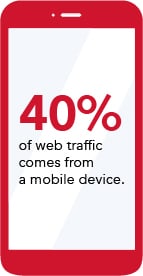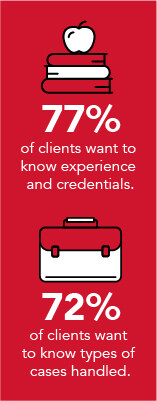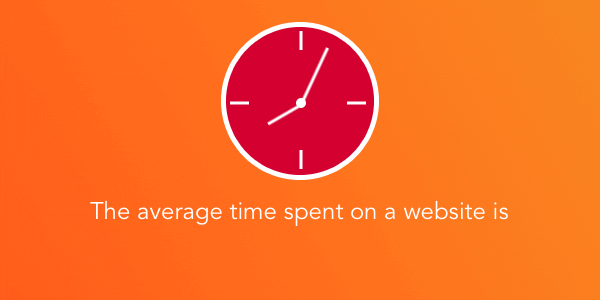In the wake of the pandemic, law firm websites have become a more critical part of the legal buyer’s journey. Lockdowns may be over, but remote work and virtual events have changed our habits profoundly and permanently.
Before COVID-19, 64 percent of in-house counsel said law firm websites were important in the selection process, according to Greentarget. After, Thomson Reuters reports that some law firms have seen website traffic increases of up to 40 percent in the post-COVID era.
Your law firm website is, increasingly, your primary opportunity to make the right first impression and to convert prospects into clients.
So it’s a shame so many firms get it wrong.
This list is certainly not exhaustive, but it chronicles seven of the most common misdeeds perpetrated by law firm websites. This is about more than pet peeves: According to Hubspot, the average time spent on a website is just 54 seconds. It is critical to connect quickly; prospects will not stick around long enough to get to know your sparkling personality buried under a clunky interface.
With every sin committed, you are likely to turn off a prospect – and send them to a competitor.
Sin One: Evasive Contact Information.
As an organization that is looking to trade legal services for legal tender, you must understand that the primary purpose of your law firm website is to connect prospective clients with the lawyers who can help them.
Your website must make it incredibly easy for prospects to find and contact your attorneys:
- Use guiding language, like “Meet Our Team,” “Who We Are,” or the concise “Attorneys” in primary navigation.
- On lawyer bios, include multiple methods of contact, such as phone, email and LinkedIn.
- Make a “Contact Us” option prominent on the top and bottom of the page. The top of the page is where people look first, while many of us have been conditioned to find phone numbers at the very bottom.
- If you have more than a handful of lawyers, include a Search option for your team, so prospective clients can filter options by practice, office and more. Do not make them hunt and peck through 20 bios to find the guy who does Bankruptcy.
Take a look at your site through the perspective of a prospective client who is running late for a meeting. How easy is it to find a phone number and an address with one hand, while driving and holding a cup of coffee?
 Sin Two: Mobile Mishaps.
Sin Two: Mobile Mishaps.
A quick review of the websites we manage shows that approximately 40% percent of traffic comes from mobile devices like phones and tablets.
Meanwhile, according to the American Bar Association’s most recent Legal Technology Survey Report, the profession gets a D for mobile-friendliness, as just 68 percent of the law firms surveyed said their websites were mobile-friendly. Six percent said they were not, and sadly, 26 percent – more than 1 in 4 – had no idea.
You cannot reasonably expect your prospects to pinch and zoom and scroll through your outdated website. In 2022, this is the equivalent of wearing a leisure suit to court.
Sin Three: Diversity Disconnects.
Too many law firm websites tout a “commitment to diversity,” but their actions don’t back this up.
For example, is your website accessible to the 15 percent of the population with a disability of some sort? Chances are, it’s not: According to the 2020 Web Accessibility Report, 98 percent of U.S.-based webpages are not accessible to the disability community. There are straightforward ways to make your website inclusive (and ADA compliant); a site that can add contrast or enlarge the type size demonstrates much more of a commitment to inclusion than hollow prose on a Diversity page.
Moreover, take a thoughtful approach to stock images and photography. (Especially if your attorney photos show a sea of white male faces.) Are you showing a representative community of sample clients? Are you showing a representative community of success stories? On the other side, take care not to present stereotypes of your “typical” clients, especially if you work in criminal defense, family law, bankruptcy or other emotionally loaded practices.
Sin Four: A Site Built for the Firm’s Lawyers, Not the Firm’s Prospects.
Your website is not the firm directory.
Your website is not the firm org chart.
Your website is built to connect with clients. This means engaging with them on their own terms. This means not designing or writing a website to feed partner egos. This means purposefully building a site with empathy and consideration for the legal buyer’s journey. What do they need to know to make a decision? What reassurance do they need?
Many firms do well by classifying their work done on behalf of industries; corporate clients are more likely to self-identify as an Agribusiness or Manufacturer than a consumer of Torts.
On the consumer side, seek to educate: Family law firm Astley Putnam includes a FAQ section on its website that answers real-world questions about divorce without using intimidating legal terms. For example, “How long will it take me to get divorced?” “Can I get divorced without going to court?” and “What are the first steps in the legal process?” The firm also pledges to “make divorce more accessible” and “We will use real language, not legal jargon.”
Your prospects are far more interested in what you can do for them – and evidence that you’ve done it before – than your firm’s history or your time on law review.
Which takes us to…
 Sin Five: Lack of Evidence.
Sin Five: Lack of Evidence.
Again, your potential clients want to know that you’ve handled a problem like theirs. In a recent Clio survey, 77 percent of clients said they wanted to know lawyers’ experience and credentials; 72 percent said they wanted to know what types of cases they have handled.
While client confidentiality is paramount, an up-to-date and user-friendly Results section is a must. This should include case studies that are relatable. No citations allowed.
Work experience is one of the four types of evidence every law firm website needs. An effective law firm website also will show happy clients, subject-matter prowess and third-party endorsements. This evidence will prove that you are a safe choice – and, ideally, worthy of a premium fee.
Sin Six: Neglecting Search Engines.
Do not adopt a Field of Dreams approach with your website. If you build it, they may not come.
Your website must be built to connect with humans, to be sure – but it cannot neglect Google and Bing. Indeed, search engines now are virtually tied with the tried-and-true prospecting method of referrals. According to Clio, when clients need lawyers, 59 percent will seek a referral, 57 percent will search on their own, and 16 percent will do both.
When analyzed by age group, referrals become less relevant: While they are highly valued by 60 percent of Boomers, that affinity drops to 46 percent for Millennials and 47 percent for Gen Z. A savvy digital presence – and prominent search results – matter significantly when courting the next generation of clients.
Search engine optimization is a field that is constantly evolving, but your site must be intentionally constructed to appeal to the algorithms. This means addressing “under the hood” items, such as meta descriptions and image file names, as well as substantive content that a crawling robot can see as authoritative.
A beautiful website that is undiscoverable by Google is a profound waste of time and money.
Sin Seven: Distracting Bells and Whistles.
Avoid popups and sounds: More often than not, these are needless distractions. Again, remember that the average visitor will spend about 54 seconds on your site; it is unlikely they will want to spend more time there if they are annoyed.
Videos, while incredible storytelling tools, should not be set to auto-play.
Chatbots should be deployed with caution: While they can be a fast resource for some practice areas, bear in mind that your visitors want to talk to a lawyer, not a robot. If a chatbot makes sense for your practice, invest in a service that provides a 24/7 human response – not a robot with a decision tree.
Most, if not all, of these sins can be avoided with a purposeful and empathetic approach to the law firm website. Bear in mind that very few clients, corporate or consumer, seek out a lawyer because they are having a great day; these are human beings in stressful situations. Your website should be an experience rooted in convenience and credibility. Your website should quickly establish trust, show that you are a safe choice, and relate to them on their terms (and their devices).

